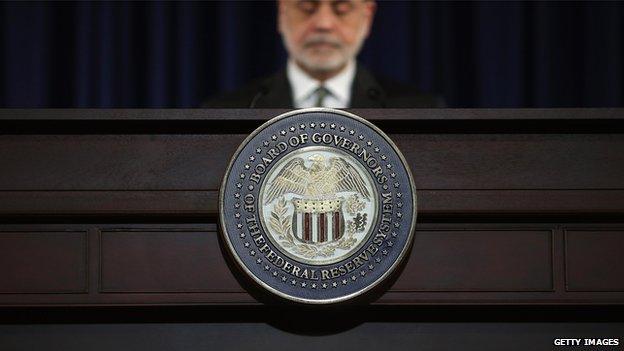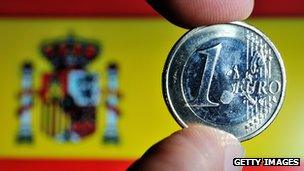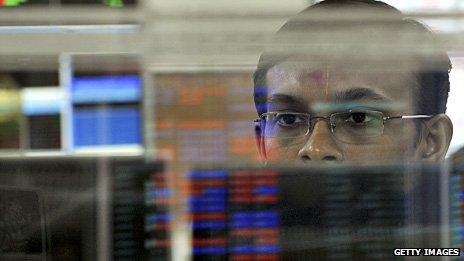How the Fed bosses all
- Published
- comments

Recent sharp movements in bond, stock and currency markets have put central banks on warning that investors have become dangerously addicted to cheap money, and of the risks of curing the addiction.
Here is what we know:
In the long run, the price of shares are determined by the performance of companies and economies, and the price of bonds by the solvency of their issuers (companies or governments) and the performance of economies.
And, in the short term, central banks can have a powerful influence on the price of bonds and shares, by creating new money, much of which is invested in bonds and shares.
Here is what we don't know: the precise contribution to the price of bonds and shares at any particular moment from investors' expectations about what is happening to the performance of companies and economies, as opposed to the contribution made by investors' expectations of the amount of new money that central banks are expected to create.
All of which makes the job of the central banker, especially those running powerful central banks in developed economies - notably the US Federal Reserve, the European Central Bank, the Bank of Japan and the Bank of England - rather scary.
And that is especially true right now.

Spanish bond yields are rising again
Because in the West, and especially in the US, investors are beginning to anticipate a slowdown in money creation, a choking off of quantitative easing. And even though the anticipated slowdown is modest, a whirlwind has been created that is battering markets all over the world.
Most significantly - and as the world's most influential bond-market investor, Bill Gross of Pimco, pointed out in May - the 30-year bull market in bonds seems to be over.
The yield on the benchmark 10-year US Treasury bond reached a low of 1.38% last July but remained closer to 1.5% than 2% for most of this year (for the uninitiated, remember that a low yield is the same thing as a high price, for a bond).
Until last month, that is, when investors began to expect there would be a reduction in the Federal Reserve's quantitative easing bond-buying programme towards the end of this year, from monthly purchases of $85bn a month to perhaps $65bn.
Now $65bn of money creation a month is still an enormous amount by historic standards. But, even so, the perception that the rate of money creation might fall by around a quarter has seen bond yields rise by more than a third and the US 10-year yield is now firmly lodged above 2% (circa 2.2% the last time I looked).
By historical standards 2% is still very low. But the yield shift from circa 1.5% to circa 2.2% is dramatic.
The best analogy is with an earthquake deep under the sea, which causes powerful waves in all the world's oceans or, in this case, in all the world's markets.
The point is that America has the largest and deepest bond market in the world. And US Treasury bonds are regarded as among the very safest investments in the world.
So when the price of US bonds fall, when the yield on US bonds rise, there is an instant re-evaluation of the attractiveness of owning all sorts of other bonds and assets.

In a globalised financial world, every market is touched, from India to South Africa to London.
Here is the thing: the relative risk of owning US bonds versus other assets has not changed materially but the price of US bonds has changed. So a fall in US bond prices causes investors to question why they should own other riskier assets, unless and until their prices fall too.
Which is why, of course, the price of those riskier assets is pulled down.
To put it another way, when the US government has to pay more to borrow because of a fall in the price of the bonds it sells, pretty much all other borrowers have to pay more to borrow too.
Thus what has happened to US bond prices isn't great for George Osborne because the price of British government bonds and gilts has fallen and the costs for the Chancellor of borrowing around £120bn this year is rising.
Still quite close to home, and of material interest to us, the sanitisation of Spanish and Italian government bonds seems to have come to an abrupt end.
The yield on their 10-year bonds seemed to be on a smooth path to around 4%, a level in the territory of affordability for the cash-strapped governments of Spain and Italy.
No longer.
Following the US bond quake, the yield on Spain's 10-year government bond is now nearer 5% than 4% and Italy's is back around 4.5%.
Yesterday, it was the ripples to emerging markets that were most conspicuous.
The Indian rupee hit a record low, while the currencies of Brazil and South Africa - as just two examples - have also been taking a battering. And (to reiterate) the reason is that investors have been pulling their money out, having reassessed the relative risk of investing there, in the light of rising US bond yields.
Now to digress a second, there is second source of massive tectonic pressure in the great oceans of world markets, which is Japan, where the central bank has been doing precisely the opposite of what is anticipated of the Federal Reserve, viz it has embarked on massive money creation to stimulate inflation.

Except that earlier this week, when the Bank of Japan did not do even more to cut the price of money, there was a hiatus in the powerful trends of recent months, namely a soaring of Japanese share prices, a weakening of the yen and a dizzying yo-yoing of bond prices.
All of which is a long-winded build-up to a statement of the bleedin' obvious - which is that markets have put central banks, and especially the US Federal Reserve, on warning of the havoc that could be caused if they botch their eventual and inevitable unwinding of quantitative easing.
Just to remind you, money has been created by central banks on an unprecedented scale since the financial crisis of 2007-8. The aim was to bring down interest rates and stimulate a recovery.
But a side-effect has been to put all manner of markets on steroids: bubbles have been created in bond markets and it is probable too that share prices have risen faster and higher than is warranted by economic recovery.
Central bankers know that investors have become addicted to all the cheap money they've created. And they also know that addiction is profoundly unhealthy.
So, as soon as economies look as though they are recovering at a steady and sustainable rate, they want to turn off the drip of cheap money.
In the US, if not in the UK, the patient - the American economy - has been looking properly on the mend, although not yet in the pink. That's why investors are convinced the Fed is contemplating a diminution of money creation.
But as we have seen, although the Federal Reserve only has formal responsibility for the welfare of the US economy, its actions affect the whole world.
In the highly unlikely event that the Fed were to dramatically turn off the drip of cheap money, markets everywhere would go into economy-threatening paroxysms.
But the longer the drip is left on, the greater the probability that a reduction in the doses at some point in the future would lead to calamity in markets and economy.
Think of it as feeding heroin to a junkie: as the addict tolerates bigger and bigger doses for longer and longer, it becomes progressively harder and more dangerous to wean the addict off.
The overwhelmingly big thing on the minds of central banks is how to break markets' addiction to cheap-money junk, without killing the patient. If they make a start this year, and chances are they will, there is reason to be more than a little anxious.